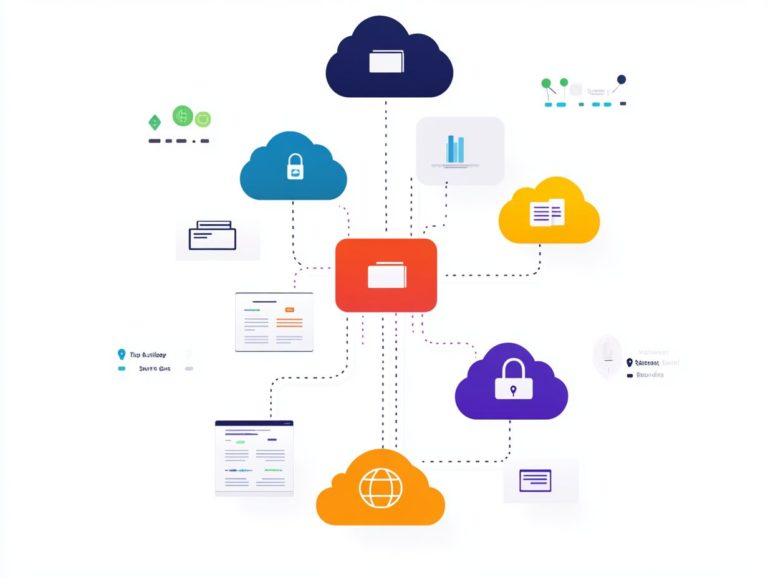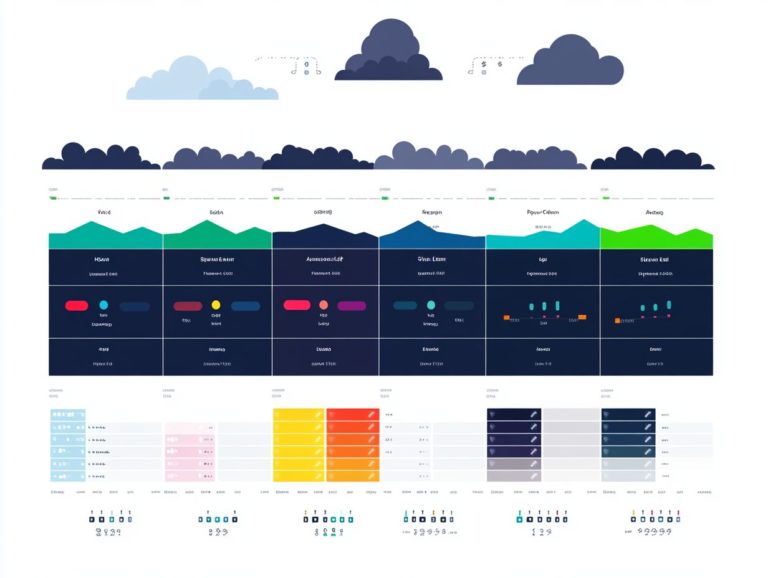Top 5 Multi-Cloud Strategies for Businesses
In today’s digital landscape, embracing a multi-cloud strategy can be a transformative move for your business, offering great flexibility, scalability, and reliability. However, navigating the intricacies of multiple cloud environments presents its own set of challenges and considerations that you must address.
Get ready to supercharge your cloud journey with practical insights tailored just for you! This article delves into the leading strategies for effectively implementing a multi-cloud approach, guiding you through understanding its benefits, pinpointing specific business goals, selecting the right providers, and ensuring robust security measures.
Contents
- Key Takeaways:
- 1. Understand the Benefits and Challenges of Multi-Cloud
- 2. Identify Your Business Needs and Goals
- 3. Choose the Right Cloud Providers
- 4. Use Smart Ways to Manage Data
- 5. Use Automation and Orchestration Tools
- 6. Ensure Security and Compliance
- 7. Train and Educate Your Team
- 8. Monitor and Optimize Performance
- 9. Have a Disaster Recovery Plan in Place
- 10. Continuously Evaluate and Adjust Your Strategy
- What Is Multi-Cloud and How Does It Differ from Hybrid Cloud?
- What Are the Key Considerations for Choosing Cloud Providers?
- How Can Businesses Effectively Manage Data Across Multiple Clouds?
- What Automation and Orchestration Tools Are Available for Multi-Cloud Management?
- What Are the Top Security Concerns with Multi-Cloud?
- How Can Businesses Ensure Compliance in a Multi-Cloud Environment?
- What Training and Education is Necessary for a Successful Multi-Cloud Strategy?
- What Are the Key Performance Metrics to Monitor in a Multi-Cloud Environment?
- How Can Disaster Recovery Plans Be Adapted for Multi-Cloud?
- What Are the Common Mistakes Businesses Make When Implementing a Multi-Cloud Strategy?
- Frequently Asked Questions
- What are the top 5 multi-cloud strategies for businesses?
- Why should businesses consider using multiple cloud providers?
- How can a mix of public and private clouds benefit businesses?
- What challenges might businesses face with a multi-cloud strategy?
- How can businesses manage their multi-cloud environment effectively?
- How often should businesses optimize their multi-cloud strategy?
Key Takeaways:
- Understand the benefits and challenges of multi-cloud to make informed decisions.
- Identify your business needs and goals to choose the right cloud providers.
- Implement effective data management and utilize automation tools for seamless multi-cloud operations.

1. Understand the Benefits and Challenges of Multi-Cloud
Understanding the benefits and challenges of a multi-cloud strategy is crucial as you seek to enhance your IT infrastructure, improve data management, and optimize cloud applications. You must deftly navigate potential pitfalls like vendor lock-in (the risk of becoming too reliant on a single cloud provider) and compliance issues.
By embracing a multi-cloud environment, you gain unparalleled flexibility that allows you to tailor solutions to your specific needs, steering clear of dependency on a single provider. This strategy facilitates cost optimization by leveraging competitive pricing among various cloud service providers and bolsters your disaster recovery capabilities by distributing critical workloads across multiple platforms.
However, these advantages come with challenges. You may encounter data portability issues, which could complicate seamless transitions between services. It becomes essential to implement robust security practices and maintain effective cloud governance, as you must manage compliance and safeguard sensitive information across diverse cloud ecosystems.
2. Identify Your Business Needs and Goals
Identifying your business needs and goals is a crucial step in crafting a successful multi-cloud strategy that aligns with your organization’s objectives and regulatory requirements for data compliance. Quick assessment of your existing systems can help you uncover gaps and seize opportunities!
By thoroughly assessing your current IT infrastructure, you can pinpoint specific cloud applications that will best meet your operational demands. This evaluation involves examining your existing systems, workflows, and tools to uncover any potential inefficiencies.
After understanding your needs, set measurable goals. For instance, you might strive for enhanced multi-cloud efficiency, better cost management, and improved data retention practices. By tracking key performance indicators related to these objectives, you can dynamically adapt your cloud strategies, ensuring optimal resource utilization and compliance in an ever-evolving technological landscape.
3. Choose the Right Cloud Providers
Choosing the right cloud providers, such as Amazon Web Services (AWS), Google Cloud Platform (GCP), and Microsoft Azure, is essential for optimizing your multi-cloud strategy and ensuring your IT infrastructure aligns with your organization s specific needs.
When you evaluate these providers, consider factors like pricing structures, as these can significantly impact your overall budget. The reliability of services cannot be overlooked; downtime can disrupt your business operations.
Data compliance capabilities are vital, as you must meet regulatory standards to protect sensitive information. Understanding how these providers manage vendor lock-in and application portability will give you the flexibility you need. This adaptability allows organizations to modify their cloud environments without being tied to a single service, ultimately fostering innovation and agility in an ever-evolving digital landscape.
4. Use Smart Ways to Manage Data
Using smart ways to manage data is essential for maintaining data portability, optimizing storage, and ensuring efficient cloud usage across various environments.
A strong approach helps you streamline your analytics and improve collaboration among teams. Data lakes, or large storage areas for data, centralize vast amounts of information, making it easily accessible for analysis while aligning with company policies.
Seamless data transfer across platforms reduces the risks associated with data silos, promoting better decision-making. Make compliance your top priority to protect sensitive data and meet regulatory requirements.
By integrating these best practices, you can navigate your cloud landscape more effectively and leverage data as a strategic asset.
5. Use Automation and Orchestration Tools
Using automation and orchestration tools like Kubernetes and DevOps practices is vital for streamlining operations and enhancing efficiency in a multi-cloud setup.
These technologies optimize resource allocation and significantly cut down on cloud expenses. Automating routine tasks helps you manage costs, ensuring you only pay for what you truly need.
Tools such as Terraform and CloudHealth provide insights into resource usage, enabling you to track spending and find areas for potential savings. With improved cloud observability, you can monitor applications and services across platforms, quickly diagnosing issues before they escalate.
This proactive approach fosters seamless integration of resources, giving you the power to operate with greater agility and responsiveness.
6. Ensure Security and Compliance
Robust security practices and data compliance are vital in a multi-cloud architecture. Protecting sensitive information while adhering to regulations is crucial, and effective disaster recovery planning is essential.
Implement essential security measures, such as encryption, to safeguard your data in transit and at rest. This effectively thwarts unauthorized access.
Identity management is also crucial; it enables strict access control and validates user identities, helping to prevent breaches.
Continuous monitoring of cloud environments is key to detecting anomalies and responding swiftly to potential threats. A comprehensive cloud governance framework helps harmonize policies across various service providers, reducing regulatory risks.
7. Train and Educate Your Team

Training your team on the intricacies of a multi-cloud strategy is essential for maximizing the effectiveness of your IT infrastructure and ensuring smooth operations.
Your team members should engage in comprehensive training covering cloud technology fundamentals. This foundational knowledge helps them grasp the principles that drive various platforms.
Placing a strong emphasis on security best practices equips everyone with the insights needed to protect sensitive data and maintain compliance across different services.
Understanding operational procedures for managing cloud applications gives your team the power to respond efficiently to issues, optimize performance, and deliver a cohesive experience.
By investing in these training areas, your organization can cultivate a skilled workforce capable of navigating the complexities of a multi-cloud landscape.
Take action today! Start implementing these strategies to enhance your multi-cloud operations and achieve immediate benefits.
8. Monitor and Optimize Performance
Monitoring and optimizing performance within a multi-cloud setup is crucial for maintaining high service levels, controlling cloud costs, and ensuring observability across various applications.
To achieve this, track specific metrics, such as application response times, throughput, error rates, and resource utilization levels.
By using powerful tools like CloudWatch, Azure Monitor, or third-party platforms like Datadog, you can gain valuable insights into your cloud environments.
These tools deliver real-time analytics and help identify patterns that may signal performance bottlenecks. Adopt best practices like automated scaling, resource tagging, and cost management dashboards to enhance visibility into cloud usage.
This proactive approach enables you to pinpoint optimization opportunities effectively, minimizing unnecessary expenses while maximizing performance.
9. Have a Disaster Recovery Plan in Place
A strong disaster recovery plan is your safety net for business continuity in a multi-cloud environment. It safeguards your data retention and maintains access to cloud applications during unforeseen events.
This requires a comprehensive approach that includes essential components, such as effective backup solutions tailored to secure your data across multiple platforms. Make sure vital information is easily retrievable.
Implement failover processes for a seamless transition to standby systems in the event of primary system failures. Regularly test your recovery plans now to avoid crises later!
By integrating these factors, you can enhance your organization s resiliency, minimize downtime, and protect your operations against various risks in different cloud setups.
10. Continuously Evaluate and Adjust Your Strategy
Continuously evaluating and adjusting your multi-cloud strategy is crucial for staying in tune with evolving business needs, optimizing cloud expenses, and enhancing overall performance.
Regular assessments help identify inefficiencies and facilitate the seamless integration of new technologies and services.
Key performance indicators (KPIs) are measurable values that show how effectively a company is achieving its business objectives. By tracking these metrics, you can easily pinpoint areas needing adjustment.
The importance of feedback cannot be overstated; it acts as a direct link to stakeholders’ experiences and expectations, guiding necessary changes to align your multi-cloud approach with your long-term organizational goals.
What Is Multi-Cloud and How Does It Differ from Hybrid Cloud?
Multi-cloud refers to using multiple cloud computing services from different providers, while hybrid cloud combines both public and private cloud environments, each offering distinct advantages in data portability and resource allocation.
By embracing a multi-cloud strategy, tap into the unique features and pricing models provided by various companies, leading to cost savings and improved performance. These strategies also help you sidestep vendor lock-in issues, giving you the freedom to switch providers or distribute workloads as needed.
This flexibility in application deployment allows for optimized resource utilization, enabling you to scale operations efficiently. With effective data management practices, ensure your data remains secure and accessible across different platforms, enhancing overall agility in an ever-evolving digital landscape.
What Are the Key Considerations for Choosing Cloud Providers?
When selecting cloud providers, key considerations include assessing the risks of vendor lock-in, ensuring application portability, and establishing robust cloud governance. This facilitates seamless integration across multiple platforms.
Evaluate the compliance certifications held by the provider, as these can significantly influence your organization’s ability to meet industry regulations and standards. Understanding the pricing models available is vital for effective budgeting and expense forecasting.
Investigate the provider’s capacity to cater to your organization’s specific data management needs, ensuring they can support growth, data security, and performance requirements.
By thoughtfully considering these factors, you can ensure the chosen cloud solution aligns seamlessly with your operational and strategic goals.
How Can Businesses Effectively Manage Data Across Multiple Clouds?
You can effectively manage data across multiple clouds by implementing centralized data management strategies, utilizing data lakes for analytics, and optimizing your cloud storage solutions to keep expenses in check.
Establishing robust data governance protocols ensures data quality and accessibility, enhancing your decision-making processes.
Employ integration techniques such as API-based connections and Extract, Transform, Load (ETL) processes to facilitate the seamless flow of information between various platforms.
Choose the right tools, like data orchestration software, to streamline your operations and unlock the full potential of your cloud environments!
Leverage automation to manage data tasks. This reduces human error and creates a more agile infrastructure that adapts to your evolving business needs.
What Automation and Orchestration Tools Are Available for Multi-Cloud Management?

Various automation and orchestration tools, such as Kubernetes and DevOps methodologies, are essential for managing multi-cloud environments. They enhance your operational efficiency and resource utilization.
These tools empower you to deploy applications seamlessly across different cloud platforms, enabling your teams to swiftly adapt to changing workload demands.
Take Kubernetes, for instance it provides container orchestration capabilities that simplify scaling operations, allowing you to handle peak traffic periods efficiently without sacrificing performance.
When integrated with monitoring solutions like Prometheus and Grafana, you gain real-time insights into application health, making it easier to proactively address potential issues.
These functionalities streamline your operations and enable greater automation, significantly reducing the time and effort required for routine maintenance tasks.
What Are the Top Security Concerns with Multi-Cloud?
Top security concerns for multi-cloud strategies may include data compliance challenges, inadequate security practices, and complexities in maintaining consistent governance across multiple providers.
You might encounter additional vulnerabilities, such as a lack of visibility into data flows and potential misconfigurations that could lead to breaches.
Regularly conducting risk assessments is essential for identifying weaknesses and understanding the ever-evolving threat landscape. Analyzing your current security posture helps pinpoint areas needing immediate attention.
Implement robust governance frameworks and employ security automation tools to enhance your defenses, ensuring compliance with regulations while streamlining management across various cloud environments.
This proactive approach allows for a more resilient architecture, enabling you to adapt to the dynamic nature of cyber threats!
How Can Businesses Ensure Compliance in a Multi-Cloud Environment?
Ensure compliance in a multi-cloud environment by establishing clear data retention policies, conducting regular audits, and leveraging tools that provide visibility into cloud applications across various providers.
Doing so equips you to navigate the intricate landscape of compliance frameworks and regulatory requirements governing data management.
Automated solutions are essential, as they streamline monitoring of data flows and identify potential compliance gaps in real-time.
By leveraging these technologies, adopt a proactive approach to data governance, ensuring that sensitive information remains secure and aligns with industry standards.
This strategy reduces the risk of non-compliance penalties and enhances your ability to respond to audits and regulatory inquiries efficiently.
What Training and Education is Necessary for a Successful Multi-Cloud Strategy?
A successful multi-cloud strategy hinges on thorough training for your IT teams, emphasizing cloud tech, data management tips, and security rules.
Consider implementing structured training programs that cover the basics of various cloud environments and the intricacies of managing hybrid systems.
Certifications from reputable cloud providers can elevate your team’s capabilities, offering them formal recognition for their expertise.
By leveraging online resources, webinars, and workshops, you can ensure that your team stays informed about the latest trends in multi-cloud solutions. Ongoing education creates a learning culture, empowering your IT professionals to implement effective strategies and align with industry best practices.
What Are the Key Performance Metrics to Monitor in a Multi-Cloud Environment?
Monitoring key performance metrics in a multi-cloud environment is essential for ensuring optimal performance and cost efficiency.
This involves keeping a close watch on crucial metrics like uptime, which guarantees consistent service availability, and response times, which greatly influence user experience.
To achieve this, you can use various tools that facilitate cloud observability and optimization.
For instance, solutions like Grafana and Prometheus offer real-time monitoring and visualization. Tools such as Datadog and New Relic provide advanced analytics, enabling you to swiftly identify performance issues and enhance operational efficiency.
How Can Disaster Recovery Plans Be Adapted for Multi-Cloud?
Adapting disaster recovery plans for your multi-cloud environment means integrating various cloud services and establishing clear protocols for recovery operations.
This approach allows you to leverage multiple platforms, creating a strong safety net that maximizes uptime and data availability.
Explore multi-cloud backup solutions that enhance redundancy and enable quicker recovery times in the event of an incident.
Implement failover mechanisms across different providers to ensure smooth transitions and minimize system outage impacts.
Your team should regularly test recovery procedures to build real confidence in your strategy!
What Are the Common Mistakes Businesses Make When Implementing a Multi-Cloud Strategy?
Common mistakes include overlooking cloud governance, underestimating the risks of being stuck with one cloud provider, and failing to plan for data integration and compliance.
To navigate these challenges, prioritize a robust cloud governance framework that outlines roles, responsibilities, and compliance measures.
Conduct thorough vendor assessments to mitigate lock-in risks, retaining greater flexibility and bargaining power.
A comprehensive strategy for data integration is vital; by using tools that facilitate seamless data flow and adhering to industry regulations, you will enhance operational efficiency and security.
Frequently Asked Questions

What are the top 5 multi-cloud strategies for businesses?
The top 5 multi-cloud strategies for businesses include:
- Choosing the right cloud providers based on specific business needs
- Implementing a hybrid cloud approach for flexibility and cost-effectiveness
- Ensuring compatibility and integration between different cloud platforms
- Establishing a strong governance and management system for the multi-cloud environment
- Regularly reviewing and optimizing the multi-cloud strategy to align with business goals
Why should businesses consider using multiple cloud providers?
Using multiple cloud providers helps businesses use the best parts of each service. It also reduces reliance on one vendor, offering flexibility and potential cost savings.
How can a mix of public and private clouds benefit businesses?
A mix of cloud types gives businesses control over sensitive data while enjoying the scalability of public clouds. It helps with restoring services after a failure and backing up data.
What challenges might businesses face with a multi-cloud strategy?
Businesses may struggle with compatibility and integration issues across different cloud platforms. They also need to manage multiple providers while ensuring security and compliance.
How can businesses manage their multi-cloud environment effectively?
Establish clear policies for using different cloud platforms. Implement consistent security measures and regularly optimize the multi-cloud strategy.
How often should businesses optimize their multi-cloud strategy?
Businesses should review their multi-cloud strategy regularly to keep up with changing goals and technology. A good rule is to assess it at least once a year, but adjust this based on specific needs.





